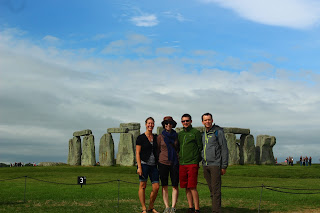The reason you have to leave early is that there is only one 'major' (two lane) highway in the area, and all of the tourists and buses clog it up. It's then made worse by all of the people slowing down to get a free look at the stones as they come over the hill. We missed all of that, but when we were standing at the circle we could see the traffic crawling along pretty slowly!
 |
| This is one of the highways in the area. Do you think there might be a prevailing wind direction? |
Originally, (in 2900 BCE, holy cow!) the Stonehenge site was a circular ditch and bank with dozens of round and equidistant holes, which archaeologists think held wooden posts. The discoverer of those holes was John Aubry, so they are named Aubrey holes. They have found cremated remains from this period so they assume this was a funeral site. It also bears resemblance to other burial mounds and barrows from the period, and there are several nearby (more easily seen from the air than the ground, so I don't have any good pictures).
Today the holes are filled in, but marked along the path around the stones.
400 years later, the first stones appeared. These were the small 'bluestones', and evidence shows they came all the way from Wales! They think they were dragged here on log rollers, which would have been a pretty massive undertaking. The assumption is that the stones must be special in some way to have gone to such trouble.
Next came the sarsen stones. These things weighed almost 30 tons and came from a nearby town called Avebury. Now when I say nearby, it's a 7 hour walk at a good pace... not dragging behemoth boulders. They have a mockup of what they would have looked like before they were in place, and it's pretty awe-inspiring.
 |
| With a Justin for scale. How many people did it take to pull these things? |
As if that wasn't impressive enough, they carved these stones using only flint (aka other stones) both to match the curvature of the circle, and to make holes and pegs to make them fit together snugly (you can see these in the pictures later). Oh yeah, and they had to somehow lift 10 ton crosspieces on top of the uprights to cap these stones.
As the picture in the visitor's centre said:
And yet they lived in houses that looked like this:That's not even taking into account the perfect alignment of Stonehenge with the rising and setting of the sun at the soltices. It just boggles the mind. If you want to know more, here is a great overview of the stages of construction at Stonehenge:
http://helios.acomp.usf.edu/~ssmagala/stonehenge/phases.html
So back to what everybody cares about: the pictures! Because we got there early, there wasn't too much of a crowd around the circle, which was awesome. Either way, because there is a bank and ditch and they keep you outside the circle (to avoid trampling down the ground there and destroying archaeological finds, as well as preventing graffiti and pillaging for souvenirs), you can generally get pictures without too many people in them. I was impressed - only a shin-high rope acts as a fence and yet in an hour we didn't see one person step over it!
 |
| We had a really great day for a visit, weather-wise! The clouds kept changing and adding drama to the scene |
Since you walk up the road towards Stonhenge and make a lap around the site, you keep seeing new vantage points of the stones, which was pretty cool.
In a few places, English Heritage (who maintain the site) have had to do some repairs on the stones to prevent them from falling over. You can see the darker rectangular concrete stabilizer at ground level on one of the stones here, which has purposely been left uncovered to demonstrate the work.
Justin was pretty jazzed about this monument from his usual engineering perspective (although there's another visit coming up that he was almost giddy about - you'll know the post when you see it!)
There were also plenty of crows spending time around the stones and helpfully posing for photos:
As we walked away from the circle, several tour buses arrived, and we were pleased that we had gotten there early and beaten the rush!
We then headed to Salisbury, where we had a great lunch on a patio in the nice weather, and nearly took the top spot at another escape room! (We are currently #5 on their leaderboard). This one is run by three retired police officers, who were looking for something fun to do and make some money in their spare time. It's crime-themed, and they had plenty of props from their careers scattered about!
We then said goodbye to David and Sarah and headed to Bath, where we snagged last-minute tickets to a play in a beautiful old theatre. Justin may have fallen asleep a couple of times, but we did have a rich full day all in all.
To mention two final things that we saw in Bath the next day (which I don't think Justin will cover in his post):
1) We found new mailbox initials!
2) I have to say I've been out of both the dating and the bar scene for a while, so maybe this is normal now, but I saw this posted in the ladies' washroom and thought it was just awesome. I wish all companies were so supportive of safety and comfort!
Justin will take over and guide you through the historic city of Bath and all of the fun water- and engineering-related facts!

































1 comment:
Pretty neat! It looks like you got a lot of fantastic shots and what a neat experience to be a part of such history.
Post a Comment